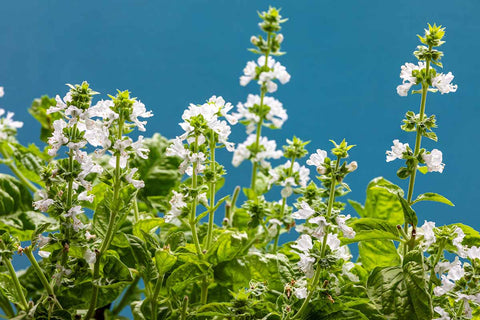Introduction
Companion planting with herbs is more than just a gardening trend; it's a time-honored practice that offers a myriad of benefits for both plants and gardeners alike. By strategically pairing herbs with other plants, gardeners can enhance flavor, repel pests, and create harmonious ecosystems in their gardens. In this article, we'll explore the importance of companion planting with herbs and how these aromatic allies can elevate your gardening experience.

Understanding Companion Planting
Companion planting involves the strategic placement of different plant species in close proximity to one another to achieve specific benefits, such as improved growth, pest control, and flavor enhancement.
Benefits of companion planting:
- Enhanced flavor in companion crops: Herbs release aromatic compounds that can enhance the flavor of neighboring vegetables, fruits, and flowers, creating a sensory delight for gardeners and cooks alike.
- Natural pest repellent properties: Many herbs possess natural defenses against common garden pests, either through their strong fragrance, bitter taste, or chemical compounds that deter or disrupt pest activity.
Herbs for Companion Planting
Culinary herbs
- Basil: This fragrant herb pairs well with tomatoes, peppers, and eggplants, enhancing their flavor and deterring pests like aphids and tomato hornworms.
- Rosemary: Known for its robust flavor and aromatic foliage, rosemary is a popular companion for beans, cabbage, and carrots, helping to repel cabbage moths, bean beetles, and carrot flies.
- Thyme: With its earthy flavor and delicate foliage, thyme complements strawberries, potatoes, and brassicas, while also deterring pests like cabbage worms and spider mites.
Medicinal herbs
- Lavender: Lavender's fragrant blooms attract pollinators and repel pests like aphids, whiteflies, and cabbage moths, making it a valuable addition to companion plantings.
- Mint: Mint's vigorous growth habit and strong aroma make it an ideal companion for peas, lettuce, and squash, while also deterring pests like aphids, flea beetles, and cabbage moths.
- Chamomile: Chamomile's dainty flowers and mild, apple-like scent make it a charming companion for cucumbers, onions, and cabbages, while also improving their growth and flavor.

Companion Planting Combinations
Herbs with vegetables: Pair aromatic herbs like basil and parsley with vegetables like tomatoes and carrots to enhance flavor and deter pests naturally.
Herbs with fruits: Integrate herbs such as thyme and lavender into orchards and berry patches to attract pollinators and discourage fruit pests.
Herbs with flowers: Interplant herbs like chamomile and sage amidst flowering perennials and annuals to promote biodiversity and repel garden pests.
Pest-Repelling Herbs
Strong-smelling herbs
- Rue: Rue emits a pungent odor that repels beetles, flies, and caterpillars, making it an effective deterrent for a wide range of garden pests.
- Catnip: Catnip contains nepetalactone, a compound that repels mosquitoes, aphids, and flea beetles, making it a valuable ally in organic pest control efforts.
Bitter-tasting herbs
- Wormwood: Wormwood's bitter taste deters pests such as slugs, snails, and aphids, making it a valuable addition to herb gardens and vegetable beds.
- Tansy: Tansy produces a strong, bitter odor that repels ants, flies, and beetles, making it an effective natural insect repellent for gardens and outdoor spaces.
Allium family herbs
- Chives: Chives emit a strong onion scent that repels aphids, Japanese beetles, and carrot flies, making them an ideal companion for vegetables and flowering plants.
- Garlic: Garlic's pungent aroma deters aphids, cabbage moths, and spider mites, making it a versatile pest repellent for garden beds and borders.
How to Implement Companion Planting with Herbs
Planning your garden layout: Consider the sunlight, soil, and space requirements of companion plants when designing your garden beds and plantings.
Selecting compatible plant combinations: Choose herbs and companion plants with similar growing needs and complementary attributes to maximize their mutual benefits.
Planting and caring for companion herbs: Plant herbs at the appropriate spacing and depth, water them regularly and provide adequate nutrients to support their growth and development.

Tips for Successful Companion Planting
Rotate plant combinations annually: Prevent the buildup of pests and diseases by rotating your companion plantings each season, avoiding planting the same crops in the same location year after year.
Monitor plant health and pest activity: Keep a close eye on your garden plants for signs of stress, disease, or pest infestations, and take prompt action to address any issues before they escalate.
Maintain proper spacing between plants: Provide ample space between companion plants to allow for adequate air circulation and sunlight penetration, reducing the risk of fungal diseases and pest outbreaks.
Challenges and Considerations
Invasive tendencies of certain herbs: Some herbs, such as mint and lemon balm, have invasive growth habits and can quickly overtake garden beds if not properly contained.
Potential allelopathic effects: Certain herbs release allelochemicals that inhibit the growth of neighboring plants, posing challenges for companion planting and crop rotation strategies.
Climate and growing conditions: Consider the climate, soil type, and microclimate of your garden when selecting herbs for companion planting, choosing varieties that are well-suited to your local growing conditions.
Examples of Successful Companion Planting Gardens
Traditional herb gardens: Explore the beauty and functionality of traditional herb gardens, where culinary and medicinal herbs are interplanted with vegetables, fruits, and flowers to create diverse and productive ecosystems.
Permaculture-inspired designs: Discover innovative permaculture designs that integrate companion planting principles into holistic garden layouts, emphasizing sustainability, biodiversity, and self-sufficiency.
Container gardens: Embrace the versatility of container gardening by planting herbs in pots and containers on patios, balconies, and windowsills, experimenting with different combinations and arrangements to maximize space and productivity.
Sustainability and Environmental Benefits
Reduced need for chemical pesticides: By harnessing the natural pest-repellent properties of herbs, gardeners can reduce their reliance on chemical pesticides, minimizing harm to beneficial insects, soil microbes, and other non-target organisms.
Conservation of biodiversity: Companion planting with herbs promotes biodiversity in the garden, creating habitats for pollinators, beneficial insects, and other wildlife that contribute to ecosystem resilience and sustainability.
Promotion of ecological balance: By mimicking natural ecosystems and fostering symbiotic relationships between plants, companion planting with herbs helps maintain ecological balance in the garden, reducing the risk of pest outbreaks and plant diseases.
Conclusion
Companion planting with herbs offers a holistic approach to gardening that benefits both plants and gardeners alike. By harnessing the power of herbs to enhance flavor and repel pests, gardeners can create thriving ecosystems that are both beautiful and productive. So whether you're planting basil alongside your tomatoes or garlic next to your roses, remember that the possibilities are endless when it comes to companion planting with herbs. Happy gardening!









